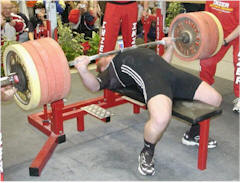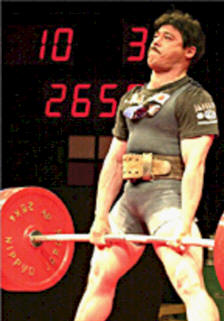About Powerlifting
View Powerlifting Promotional Video
Strength is the primary ingredient of athletic performance. Powerlifting's lifts are the definitive measure of strength. Powerlifting is the ultimate strength competition. The powerlifting athlete competes in three specific disciplines, each designed to measure different areas of human strength. The sum or total of the best lift in each discipline determines the winner. Powerlifting is an exciting sport where athletes compete against the force of iron as well as other athletes.
Powerlifting is an international sport practiced in close to 100 countries on all continents. Athletes, men and women from age 14 to 80, compete in given age groups and weight categories. Weight categories begin with 43kg women's class and end in the men's over 120+kg class (unlimited). Powerlifters are unique athletes competing in an exciting sport. They move massive amounts of weight in hi-tech supportive gear that protects against injury. Contests and appreciative fans can be found from Delhi, India, to Dallas, USA. The unique powerlifting athletes compete in a wide variety of local, state, regional,national and international competitions.
The three disciplines, in contest order, that make up the sport are the Squat, Bench press and Deadlift.
Squat
The lift starts with the lifter standing erect and the bar loaded with weights resting on the lifter,s shoulders. At the referee's command the lift begins. The lifter bends his knees and lowers himself into a squatting position with the hips slightly below parallel position. The lifter returns to an erect position. At the referees command the bar is returned to the rack and the lift is completed.

Bench Press
With his or her back resting on the bench, the lifter takes the loaded bar at arm's length. At the referee's command the powerlifter lowers the bar to the chest. On the chest there must be a visible pause. The powerlifter pushes the weight up until the arms are straight and the elbows locked. Then the referee will call 'rack' and the lift is completed as the weight is retuned to the rack.

Deadlift
The deadlift is often described as the king of the powerlifting disciplines. In the deadlift the athlete grasps the loaded bar which is resting on the platform floor. The powerlifter pulls the weights off the floor and assumes a standing erect position. The knees must be locked and shoulders back with the weight held in the lifters's grip. At the referees command the bar will be returned to the floor under the control of the lifter.

IPF FORMULA
After having switched in 2018 to the new IPF Formula, the IPF did an evaluation of this method in 2019. This evaluation has been done by a team consisting of Oleksandr Kopayev, Dr. Borys Onyshchenko and Dr. Anatoliy Stetsenko. The reason for this evaluation is, because we realised that the Formula we implemented in 2018 is still not balanced and fair to all lifters. As we are a modern federation and want to be fair to all, we are always striving to optimise all processes in our federation and in this case also the bodyweight coefficient. This is a part of our evolution and most important for our sport to be up to date, most fair and integre.
The result of the evaluation is that the team around Mr. Kopayev could find out another calculating method, which is more fair among all weight classes. For this reason, the IPF Executive Board decided to replace the 2018 introduced IPF Formula with the new IPF GL Points.
The new points will be valid with 1st May 2020 and will be used on all IPF sanctioned events (IPF World Championships and World Events, Regional Championships,…).
The IPF encourages all of our member federations, also using the new IPF GL Points on all national events to guarantee that all lifters around the world are using and calculating with the one and same method.
With this you all can ensure that the lifters, who competing on national events, will have immediately the chance to compare their results with other lifters on the globe.
The IPF did an evaluation based on scientific knowledge to find a fair method. It is the duty for all member federations using the one and same bodyweight calculator around the world, instead to mix it up with others.
See IPF Formula
Age Categories
MEN
Open: from the day he reaches 14 years and upwards (no category restrictions need apply).
Sub-Junior: from the day he reaches 14 years and throughout the full calendar year in which he reaches 18 years.
Junior: from 1 January in the calendar year he reaches 19 years and throughout the full calendar year in which he reaches 23 years.
Master I: from 1 January in the calendar year he reaches 40 years and throughout the full calendar year in which he reaches 49 years.
Master II: from 1 January in the calendar year he reaches 50 years and throughout the full calendar year in which he reaches 59 years.
Master III: from 1 January in the calendar year he reaches 60 years and throughout the full calendar year in which he reaches 69 years.
Master IV: from 1 January in the calendar year he reaches 70 years and upwards. It must be recognized that Master IV age category is not included in class weights.
WOMEN
Open: from the day she reaches 14 years and upwards (no category restrictions need apply).
Sub-Junior: from the day she reaches 14 years and throughout the full calendar year in which she reaches 18 years.
Junior: from 1 January in the calendar year she reaches 19 years and throughout the full calendar year in which she reaches 23 years.
Master I: from 1 January in the calendar year she reaches 40 years and throughout the full calendar year in which she reaches 49 years.
Master II: from 1 January in the calendar year she reaches 50 years and throughout the full calendar year in which she reaches 59 years.
Master III: from 1 January in the calendar year she reaches 60 years and upwards. It must be recognized that Master III age category is not included in class weights.
Competitive lifting shall be restricted to competitors aged 14 years and older.
Weight Divisions
MEN
Sub-Junior & Junior only-up to 53.0 kg
59.0 kg Class up to 59.0 kg
66.0 kg Class from 59.01 kg up to 66.0 kg
74.0 kg Class from 66.01 kg up to 74.0 kg
83.0 kg Class from 74.01 kg up to 83.0 kg
93.0 kg Class from 83.01 kg up to 93.0 kg
105.0 kg Class from 93.01 kg up to 105.0 kg
120.0 kg Class from 105.01 kg up to 120.0 kg
120.0+ kg Class from 120.01 kg up to unlimited
WOMEN
Sub-Junior & Junior only-up to 43.0 kg
47.0 kg Class up to 47.0 kg
52.0 kg Class from 47.01 kg up to 52.0 kg
57.0 kg Class from 52.01 kg up to 57.0 kg
63.0 kg Class from 57.01 kg up to 63.0 kg
69 kg Class from 63.01 kg up to 69.0 kg
76.0 kg Class from 69.01 kg up to 76.0 kg
84.0 kg Class from 72.01 kg up to 84.0 kg
84.0+ kg Class from 84.01 kg up to unlimited.
The first powerlifting competitions were organized in the early 1960s. Powerlifting has a steady growth and at present there are over 500'000 athletes. The International Powerlifting Federation (IPF) governs all competitions in 92 member nations. The IPF has a banned substance abuse policy that mirrors the IOC's policy. The IPF conducts consistently in and out of competition drug testing.



